Akasa M.2 SSD Enclosures Reviewed: Giving Spare Drives a New Lease of Life
by Ganesh T S on September 22, 2021 8:00 AM ESTPCMark 10 Storage Bench - Real-World Access Traces
There are a number of storage benchmarks that can subject a device to artificial access traces by varying the mix of reads and writes, the access block sizes, and the queue depth / number of outstanding data requests. We saw results from two popular ones - ATTO, and CrystalDiskMark - in a previous section. More serious benchmarks, however, actually replicate access traces from real-world workloads to determine the suitability of a particular device for a particular workload. Real-world access traces may be used for simulating the behavior of computing activities that are limited by storage performance. Examples include booting an operating system or loading a particular game from the disk.
PCMark 10's storage bench (introduced in v2.1.2153) includes four storage benchmarks that use relevant real-world traces from popular applications and common tasks to fully test the performance of the latest modern drives:
- The Full System Drive Benchmark uses a wide-ranging set of real-world traces from popular applications and common tasks to fully test the performance of the fastest modern drives. It involves a total of 204 GB of write traffic.
- The Quick System Drive Benchmark is a shorter test with a smaller set of less demanding real-world traces. It subjects the device to 23 GB of writes.
- The Data Drive Benchmark is designed to test drives that are used for storing files rather than applications. These typically include NAS drives, USB sticks, memory cards, and other external storage devices. The device is subjected to 15 GB of writes.
- The Drive Performance Consistency Test is a long-running and extremely demanding test with a heavy, continuous load for expert users. In-depth reporting shows how the performance of the drive varies under different conditions. This writes more than 23 TB of data to the drive.
Despite the data drive benchmark appearing most suitable for testing direct-attached storage, we opt to run the full system drive benchmark as part of our evaluation flow. Portable flash drives are also used as boot drives and storage for Steam games. These types of use-cases are addressed only in the full system drive benchmark.
The Full System Drive Benchmark comprises of 23 different traces. For the purpose of presenting results, we classify them under five different categories:
- Boot: Replay of storage access trace recorded while booting Windows 10
- Creative: Replay of storage access traces recorded during the start up and usage of Adobe applications such as Acrobat, After Effects, Illustrator, Premiere Pro, Lightroom, and Photoshop.
- Office: Replay of storage access traces recorded during the usage of Microsoft Office applications such as Excel and Powerpoint.
- Gaming: Replay of storage access traces recorded during the start up of games such as Battlefield V, Call of Duty Black Ops 4, and Overwatch.
- File Transfers: Replay of storage access traces (Write-Only, Read-Write, and Read-Only) recorded during the transfer of data such as ISOs and photographs.
PCMark 10 also generates an overall score, bandwidth, and average latency number for quick comparison of different drives. The sub-sections in the rest of the page reference the access traces specified in the PCMark 10 Technical Guide.
Booting Windows 10
The read-write bandwidth recorded for each drive in the boo access trace is presented below.
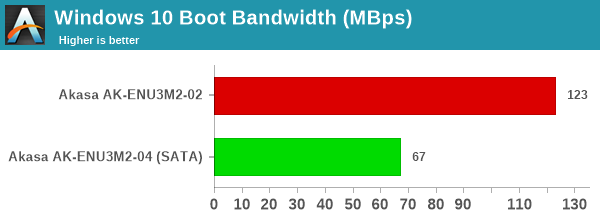
The pure SATA bridge configuration with the VIA VL716 outperforms the Realtek solution by a significant margin.

The pure NVMe bridge with the thermal solution (AK-ENU3M2-03) outperforms the Realtek solution, but the gulf is not as significant as what was seen in the SATA case.
Creative Workloads
The read-write bandwidth recorded for each drive in the sacr, saft, sill, spre, slig, sps, aft, exc, ill, ind, psh, and psl access traces are presented below.

The WD Red SA500 performs better in the AK-ENU3M2-02 (pure SATA bridge) compared to the Realtek solution (multi-protocol bridge) across all creative workloads.
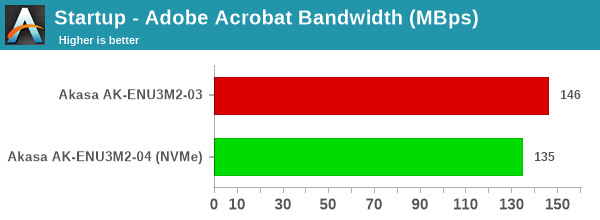
The SK hynix Gold P31 performs better in the AK-ENU3M2-03 (pure NVMe bridge) compared to the multi-protocol Realtek bridge solution across all creative workloads.
Office Workloads
The read-write bandwidth recorded for each drive in the exc and pow access traces are presented below.
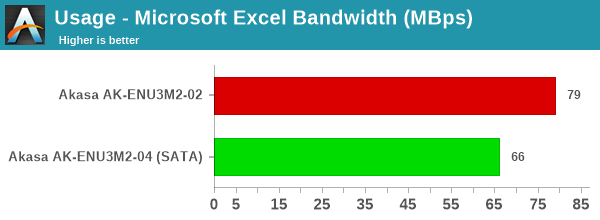
The pure bridge solution fares better for office workloads, though the difference is not as significant as what was seen in other workloads.
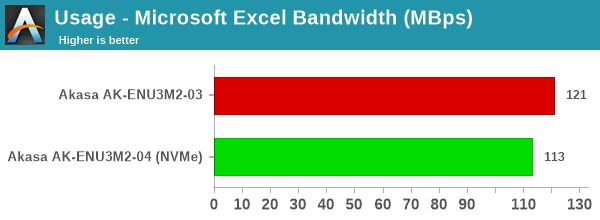
In the NVMe case too, we find the pure bridge solution faring better in the office workloads.
Gaming Workloads
The read-write bandwidth recorded for each drive in the bf, cod, and ow access traces are presented below.
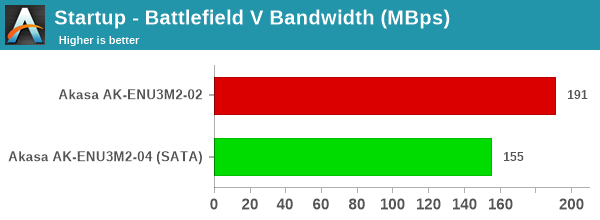
The pure bridge solution fares better for the read intensive workloads in both the SATA and NVMe cases.
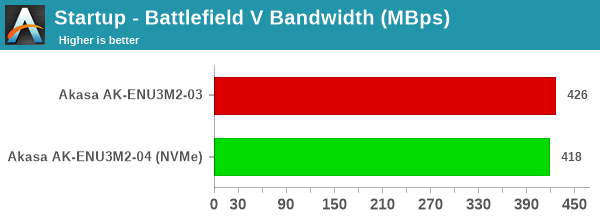
The difference between the pure and multi-protocol solution is more significant in the SATA case compared to NVMe.
Files Transfer Workloads
The read-write bandwidth recorded for each drive in the cp1, cp2, cp3, cps1, cps2, and cps3 access traces are presented below.
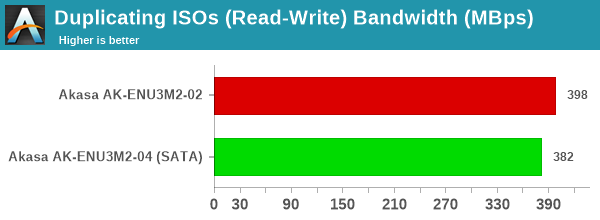
The pure SATA bridge fares better than the multi-protocol solution across the board for all file transfer workloads.
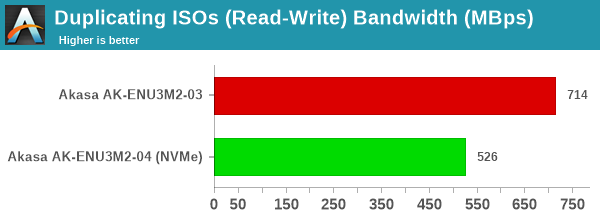
In the NVMe case, the two solutions fare similarly for pure read and pure write scenarios. However, for simultaneous reads and writes, the pure NVMe bridge solution with the ASMedia ASMM2362 outperforms the Realtek solution.
Overall Scores
PCMark 10 reports an overall score based on the observed bandwidth and access times for the full workload set. The score, bandwidth, and average access latency for each of the drives are presented below.
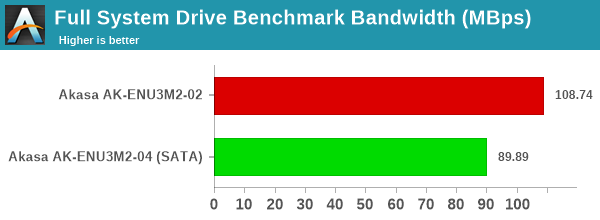
The WD Red SA500 in the pure SATA bridge solution scores 687 compared to the 550 of the multi-protocol solution.
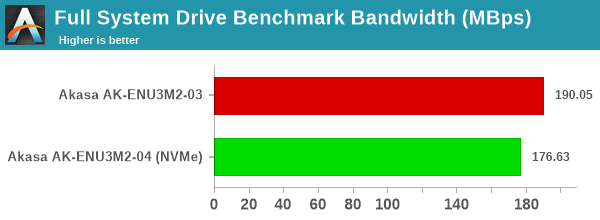
The SK hynix Gold P31 in the pure NVMe bridge solution scores 1214 compared to the 1122 of the multi-protocol solution.
Overall, we find that the multi-protocol Realtek RTL9210B-CG solution should not be preferred over pure bridge solutions when performance is important.










15 Comments
View All Comments
ganeshts - Wednesday, September 22, 2021 - link
The Turing fanless case we reviewed last year is still doing great in deployment, and I don't think we have reviewed any Akasa gear after that. The storage bridges we reviewed in this article came in early last year, and the multi-protocol unit has been 'abused' greatly across multiple systems - has been working great for the last couple of months. The other two bridges were subject to only our evaluation process with a single host port, and that in itself is quite rigorous (multiple portable SSDs / storage bridges have experiences dropouts under heavy traffic, but no such issues with the Akasa bridges).Tomatotech - Thursday, September 23, 2021 - link
Thankfully I’ve successfully avoided buying any SATA m.2 drives. There must be people out there who were forced by circumstances into buying them, but I haven’t met any. Are there AnandTech readers out there who had to buy them?anad0commenter - Friday, September 24, 2021 - link
Does any of these work with the Plextor m6e AHCI PCIe m.2 SSD? It's one of the weirdest SSDs out there, which came out before NVMe became popular. And for the life of me, I can't find an enclosure that will work with it. SATA m.2 enclosures don't seem to be compatible.Tomatotech - Sunday, September 26, 2021 - link
I think you want an AHCI adaptor. It’s a little dongle about an inch wide that goes between the SSD and the m.2 socket. I’m not sure if we’re talking about the same thing here, but Apple used a weird type of SSD for several years 2013-2015ish. So there’s a bit of a market for adaptors to retrofit the Mac laptops so that they can use modern NVMe drives. I have 2 of these adaptors in my Mac laptops.The problem is the adaptors that are available are intended to let a modern nvme ssd fit into Apple’s weird socket (it was designed before the nvme standard was nailed down). What you’re after is an adaptor to let your weird drive fit into a modern socket. Good luck searching. I haven’t had much luck finding adaptors to let me re-use my surplus Apple OEM m.2(ish) drives as a portable ssd.
(Don’t want to sell my Apple OEM drives as some OS bootrom upgrades prefer the original drive in place.). TBH at this point in time I regard any non-NVMe ssd as a lost cause and effectively worthless, at least in the smaller sizes.
anad0commenter - Tuesday, September 28, 2021 - link
The adaptor was a good idea, but it turns out that it's only for macbooks, which use a 12+16 pin notch. So when I put the Plextor SSD on one side, the other side of the adaptor will not go into a standard m.2 slot which has a notch after 5 pins.There's a USB3.0 enclosure on ebay that claims it's AHCI NGFF compatible. But it costs $70!! Not sure if it's worth the risk to find out of it works with the Plextor....